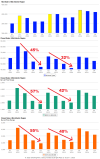shrubberyvaluation
Elite Member
- Joined
- May 2, 2012
- Professional Status
- Appraiser Trainee
- State
- Maryland
Oh ok, I guess it depends on how comparable the properties are in your dataset.The reason the median price tends to dip from spring into the end of the year is not because values are dipping. The reason it looks like that is because the mix of properties that sell throughout the year is not the same. It is because the properties that sell towards the end of the year are generally inferior to the properties that sell during the spring.
You can't analyze real estate data without understanding that this is the nature of the data.


